Munson B.R. Fundamentals of Fluid Mechanics
Подождите немного. Документ загружается.


A.5 Basic Representative Examples 707
For most CFD problems the governing equations to be solved are partial differential equa-
tions [rather than an ordinary differential equation as in the above example (Eq. A.1)] and the
finite difference method becomes considerably more involved. The following example illustrates
some of the concepts involved.
or
(7)
We cannot use Eq. 7 for since it would involve the non-
existing Rather we use the initial condition 1Eq. 42, which gives
The result is the following set of N algebraic equations for the N ap-
proximate values of hat times
For most problems the corresponding equations would be more
complicated than those just given, and a computer would be used to
solve for the For this problem the solution is simply
. . .
. . .
h
3
⫽ H
Ⲑ
11 ⫹ ¢t2
2
h
2
⫽ H
Ⲑ
11 ⫹ ¢t2
h
i
.
h
N
⫽ h
N⫺1
Ⲑ
11 ⫹ ¢t2
. . .
. . .
h
3
⫽ h
2
Ⲑ
11 ⫹ ¢t2
h
2
⫽ h
1
Ⲑ
11 ⫹ ¢t2
h
1
⫽ H
1N ⫺ 12¢t.
⫽ ¢t, . . . , t
N
⫽t
1
⫽ 0, t
2
h
1
⫽ H
h
0
.
i ⫽ 1
h
i
⫽
h
i⫺1
11 ⫹ ¢t2
or in general
The results for are shown in Fig. EA.1c. Tabulated
values of the depth for are listed in the table below.t ⫽ 1
0 6 t 6 1
h
i
⫽ H
Ⲑ
11 ⫹ ¢t2
i⫺1
It is seen that the approximate results compare quite favorably
with the exact solution given by Eq. 5. It is expected that the finite
difference results would more closely approximate the exact re-
sults as is decreased since in the limit of the finite dif-
ference approximation for the derivatives 1Eq. 62approaches the
actual definition of the derivative.
¢t S 0¢t
i for
0.2 6 0.4019H
0.1 11 0.3855H
0.01 101 0.3697H
0.001 1001 0.3681H
Exact 1Eq. 52 — 0.3678H
h
i
for t ⴝ 1t ⴝ 1⌬t
Consider steady, incompressible flow of an inviscid fluid past a
circular cylinder as shown in Fig. EA.2a. The stream function,
for this flow is governed by the Laplace equation 1see Section 6.52
(1)
0
2
c
0x
2
⫹
0
2
c
0y
2
⫽ 0
c,
The exact analytical solution is given in Section 6.6.3.
Describe a simple finite difference technique that can be used
to solve this problem.
S
OLUTION
Flow Past a Cylinder
artificial, uniform flow conditions at a location where the actual
flow is not uniform. If these boundaries are farther than neces-
sary from the object, the flow domain will be larger than neces-
sary and excessive computer time and storage will be required.
Experience in solving such problems is invaluable!
Once the flow domain has been selected, an appropriate grid is
imposed on this domain 1see Fig. EA.2b2. Various grid structures
can be used. If the grid is too coarse, the numerical solution may
not be capable of capturing the fine scale structure of the actual
flow field. If the grid is too fine, excessive computer time and
E
XAMPLE A.2
The first step is to define a flow domain and set up an appropri-
ate grid for the finite difference scheme. Since we expect the
flow field to be symmetrical both above and below and in front
of and behind the cylinder, we consider only one-quarter of the
entire flow domain as indicated in Fig. EA.2b. We locate the up-
per boundary and right-hand boundary far enough from the
cylinder so that we expect the flow to be essentially uniform at
these locations. It is not always clear how far from the object
these boundaries must be located. If they are not far enough, the
solution obtained will be incorrect because we have imposed
JWCL068_AppA_701-713.qxd 9/23/08 12:07 PM Page 707
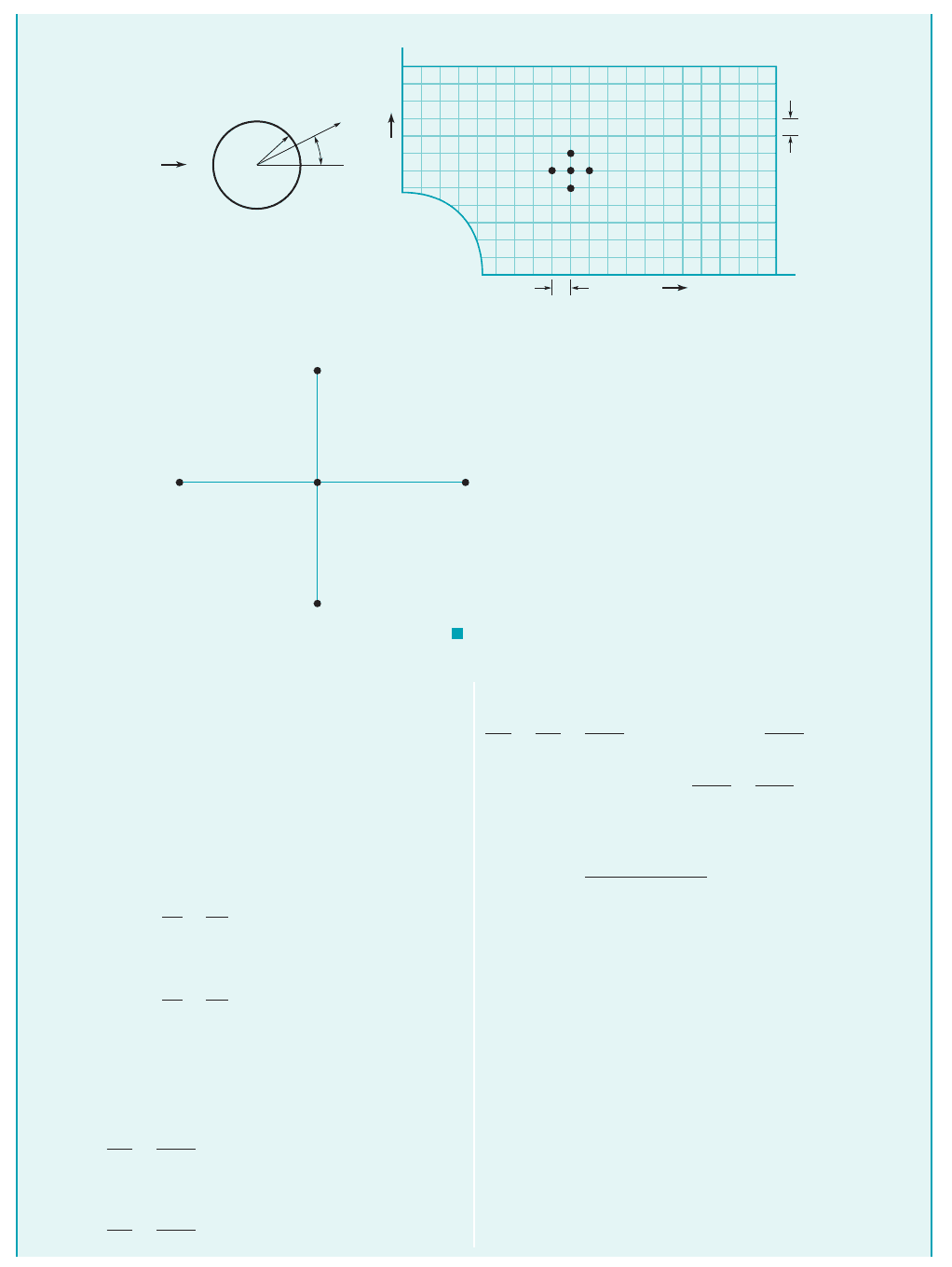
708 Appendix A ■ Computational Fluid Dynamics and FlowLab
storage may be required. Considerable work has gone into form-
ing appropriate grids 1Ref. 62. We consider a grid that is uniformly
spaced in the x and y directions, as shown in Fig. EA.2b.
As shown in Eq. 6.112, the exact solution to Eq. 1 1in terms
of polar coordinates r, rather than Cartesian coordinates x, y2
is The finite difference solution ap-
proximates these stream function values at a discrete 1finite2
number of locations 1the grid points2as where the i and j in-
dices refer to the corresponding and locations.
The derivatives of can be approximated as follows:
and
This particular approximation is called a forward-difference ap-
proximation. Other approximations are possible. By similar rea-
soning, it is possible to show that the second derivatives of can
be written as follows:
(2)
and
(3)
0
2
c
0y
2
⬇
1
1¢y2
2
1c
i, j⫹1
⫺ 2c
i, j
⫹ c
i, j⫺1
2
0
2
c
0x
2
⬇
1
1¢x2
2
1c
i⫹1, j
⫺ 2c
i, j
⫹ c
i⫺1, j
2
c
0c
0y
⬇
1
¢y
1c
i, j⫹1
⫺ c
i, j
2
0c
0x
⬇
1
¢x
1c
i⫹1, j
⫺ c
i, j
2
c
y
j
x
i
c
i, j
,
c ⫽ Ur11 ⫺ a
2
Ⲑ
r
2
2 sin u.
u
Thus, by combining Eqs. 1, 2, and 3 we obtain
(4)
Equation 4 can be solved for the stream function at and to give
(5)
Note that the value of depends on the values of the stream
function at neighboring grid points on either side and above and
below the point of interest 1see Eq. 5 and Fig. EA. 2c2.
To solve the problem 1either exactly or by the finite difference
technique2it is necessary to specify boundary conditions for
points located on the boundary of the flow domain 1see Section
6.6.32. For example, we may specify that on the lower
boundary of the domain 1see Fig. EA.2b2and a constant,
on the upper boundary of the domain. Appropriate boundary con-
ditions on the two vertical ends of the flow domain can also be
specified. Thus, for points interior to the boundary Eq. 5 is valid;
similar equations or specified values of are valid for boundary
points. The result is an equal number of equations and unknowns,
one for every grid point. For this problem, these equations
represent a set of linear algebraic equations for the solutionc
i, j
,
c
i, j
,
c
i, j
c ⫽ C,
c ⫽ 0
c
i, j
⫹ 1¢x2
2
1c
i, j⫹1
⫹ c
i, j⫺1
24
c
i, j
⫽
1
231¢x2
2
⫹ 1¢y2
2
4
31¢y2
2
1c
i⫹1, j
⫹ c
i⫺1, j
2
y
j
x
i
⫹ c
i, j⫺1
2⫺ 2 a
1
1¢x2
2
⫹
1
1¢y2
2
b c
i, j
⫽ 0
0
2
c
0x
2
⫹
0
2
c
0y
2
⬇
1
1¢x2
2
1c
i⫹1, j
⫹ c
i⫺1, j
2⫹
1
1¢y2
2
1c
i, j⫹1
i
j
+
y
x
+
θ
r
a
x
Δ
y
Δ
i, j + 1
x
Δ
y
Δ
x
Δ
y
Δ
i, j
i, j
– 1
i – 1, j i + 1, j
U
ψψ
ψ
ψ
ψ
(a)
(b)
(c)
F I G U R E EA.2
JWCL068_AppA_701-713.qxd 9/23/08 12:07 PM Page 708
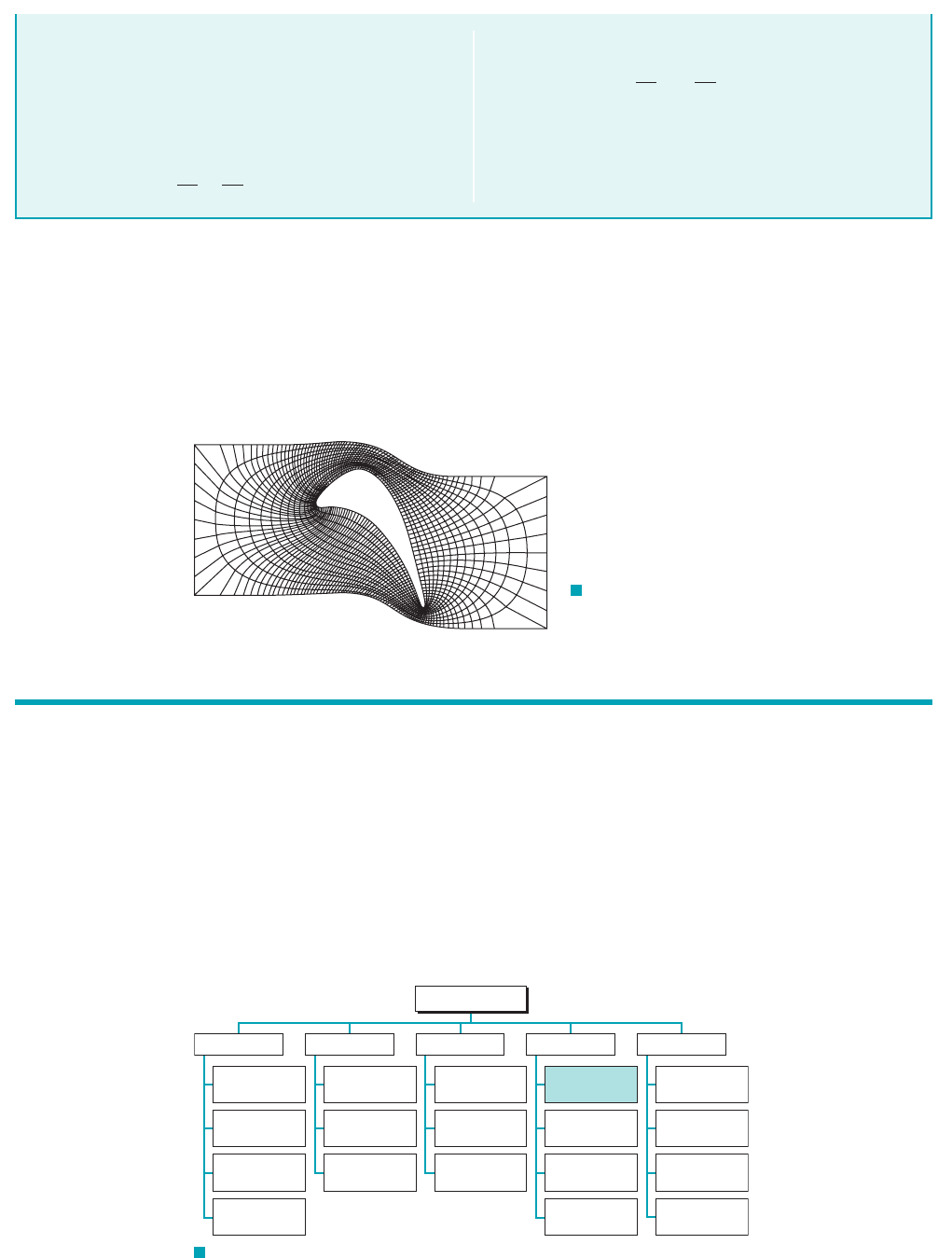
A.6 Methodology
In general, most applications of CFD take the same basic approach. Some of the differences
include problem complexity, available computer resources, available expertise in CFD, and
whether a commercially available CFD package is used, or a problem-specific CFD algorithm is
developed. In today’s market, there are many commercial CFD codes available to solve a wide
variety of problems. However, if the intent is to conduct a thorough investigation of a specific
fluid flow problem such as in a research environment, it is possible that taking the time to develop
a problem-specific algorithm may be most efficient in the long run. The features common to most
CFD applications can be summarized in the flow chart shown in Fig. A.6. A complete, detailed
CFD solution for a viscous flow obtained by using the steps summarized in the flow chart can
be accessed from the book’s website at www.wiley.com/college/munson.
A.6 Methodology 709
The preceding two examples are rather simple because the governing equations are not too
complex. A finite difference solution of the more complicated, nonlinear Navier–Stokes equation
(Eq. 6.127) requires considerably more effort and insight and larger and faster computers. A typ-
ical finite difference grid for a more complex flow, the flow past a turbine blade, is shown in Fig.
A.5. Note that the mesh is much finer in regions where large gradients are to be expected (i.e.,
near the leading and trailing edges of the blade) and more coarse away from the blade.
of which provides the finite difference approximation for the
stream function at discrete grid points in the flow field. Stream-
lines 1lines of constant 2can be obtained by interpolating values
of between the grid points and “connecting the dots” of
The velocity field can be obtained from the deriva-
tives of the stream function according to Eq. 6.74. That is,
u ⫽
0c
0y
⬇
1
¢y
1c
i, j⫹1
⫺ c
i, j
2
c ⫽ constant.
c
i, j
c
and
Further details of the finite difference technique can be found in
standard references on the topic 1Refs. 5, 7, 82. Also, see the com-
pletely solved viscous flow CFD problem in Section A6.
v ⫽⫺
0c
0x
⬇ ⫺
1
¢x
1c
i⫹1, j
⫺ c
i, j
2
F I G U R E A.5 Finite difference
grid for flow past a turbine blade. (From Ref. 9,
used by permission.)
CFD Methodology
Problem
Models
Governing
Equations
Assumptions &
Simplifications
Algorithm
Development
Run Simulation
Steady/
Unsteady
Convergence
Geometry
Special
Requirements
Structured or
Unstructured
Discretization
Method
Implicit or
Explicit
Accuracy
Verification
& Validation
Visualize
Flow Field
Postprocess
Values
Interpret
Results
Physics Discretize Solve AnalyzeGrid
F I G U R E A.6 Flow chart of general CFD methodology.
JWCL068_AppA_701-713.qxd 9/23/08 12:07 PM Page 709

710 Appendix A ■ Computational Fluid Dynamics and FlowLab
The Algorithm Development box is grayed because this step is required only when devel-
oping your own CFD code. When using a commercial CFD code, this step is not necessary. This
chart represents a generalized methodology to CFD. There are other more complex components
that are hidden in the above steps, which are beyond the scope of a brief introduction to CFD.
A.7 Application of CFD
In the early stages of CFD, research and development was primarily driven by the aerospace
industry. Today, CFD is still used as a research tool, but it also has found a place in industry as
a design tool. There is now a wide variety of industries that make at least some use of CFD,
including automotive, industrial, HVAC, naval, civil, chemical, biological, and others. Industries
are using CFD as an added engineering tool that complements the experimental and theoretical
work in fluid dynamics.
A.7.1 Advantages of CFD
There are many advantages to using CFD for simulation of fluid flow. One of the most important
advantages is the realizable savings in time and cost for engineering design. In the past, coming up
with a new engineering design meant somewhat of a trial-and-error method of building and testing
multiple prototypes prior to finalizing the design. With CFD, many of the issues dealing with fluid
flow can be flushed out prior to building the actual prototype. This translates to a significant sav-
ings in time and cost. It should be noted that CFD is not meant to replace experimental testing, but
rather to work in conjunction with it. Experimental testing will always be a necessary component
of engineering design. Other advantages include the ability of CFD to: (1) obtain flow information
in regions that would be difficult to test experimentally, (2) simulate real flow conditions, (3) con-
duct large parametric tests on new designs in a shorter time, and (4) enhance visualization of com-
plex flow phenomena.
A good example of the advantages of CFD is shown in Figure A.7. Researchers use a type of
CFD approach called “large-eddy simulation” or LES to simulate the fluid dynamics of a tornado as
it encounters a debris field and begins to pick up sand-sized particles. A full animation of this tor-
nado simulation can be accessed by visiting the book website. The motivation for this work is to
investigate whether there are significant differences in the fluid mechanics when debris particles are
present. Historically it has been difficult to get comprehensive experimental data throughout a tor-
nado so CFD is helping to shine some light on the complex fluid dynamics involved in such a flow.
A.7.2 Difficulties in CFD
One of the key points that a beginning CFD student should understand is that one cannot treat the
computer as a “magic black box” when performing flow simulations. It is quite possible to obtain a
fully converged solution for the CFD simulation, but this is no guarantee that the results are physi-
cally correct. This is why it is important to have a good understanding of the flow physics and how
they are modeled. Any numerical technique (including those discussed above), no matter how sim-
ple in concept, contains many hidden subtleties and potential problems. For example, it may seem
reasonable that a finer grid would ensure a more accurate numerical solution. While this may be true
(as Example A.1), it is not always so straightforward; a variety of stability or convergence problems
may occur. In such cases the numerical “solution” obtained may exhibit unreasonable oscillations or
the numerical result may “diverge” to an unreasonable (and incorrect) result. Other problems that
may arise include (but are not limited to): (1) difficulties in dealing with the nonlinear terms of the
Navier–Stokes equations, (2) difficulties in modeling or capturing turbulent flows, (3) convergence
issues, (4) difficulties in obtaining a quality grid for complex geometries, and (5) managing resources,
both time and computational, for complex problems such as unsteady three-dimensional flows.
A.7.3 Verification and Validation
Verification and validation of the simulation are critical steps in the CFD process. This is a neces-
sary requirement for CFD, particularly since it is possible to have a converged solution that is non-
physical. Figure A.8 shows the streamlines for viscous flow past a circular cylinder at a given instant
VA.3 Tornado
simulation
JWCL068_AppA_701-713.qxd 9/23/08 12:07 PM Page 710
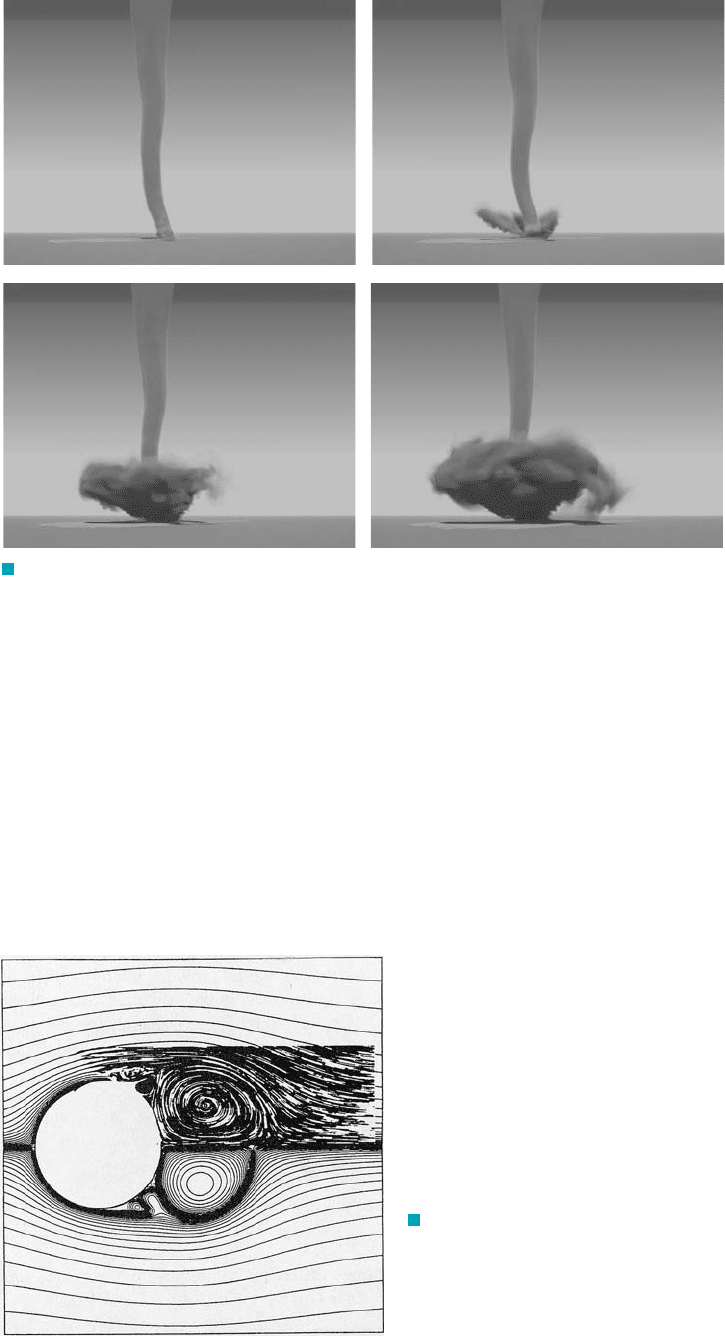
A.7 Application of CFD 711
after it was impulsively started from rest. The lower half of the figure represents the results of a finite
difference calculation; the upper half of the figure represents the photograph from an experiment of
the same flow situation. It is clear that the numerical and experimental results agree quite well. For
any CFD simulation, there are several levels of testing that need to be accomplished before one can
have confidence in the solution. The most important verification to be performed is grid convergence
testing. In its simplest form, it consists of proving that further refinement of the grid (i.e., increasing
the number of grid points) does not alter the final solution. When this has been achieved, you have a
grid-independent solution. Other verification factors that need to be investigated include the suitability
F I G U R E A.7 Results from a large-eddy simulation showing the visual appear-
ance of the debris and funnel cloud from a simulated medium swirl F3-F4 tornado. The fun-
nel cloud is translating at 15 m/s and is ingesting 1-mm-diameter “sand” from the surface as
it encounters a debris field. Please visit the book website to access a full animation of this
tornado simulation. (Photographs and animation courtesy of Dr. David Lewellen, Ref. 10, and
Paul Lewellen, West Virginia University.)
F I G U R E A.8 Streamlines for flow past
a circular cylinder at a short time after the flow was
impulsively started. The upper half is a photograph
from a flow visualization experiment. The lower half is
from a finite difference calculation. (See the photo-
graph at the beginning of Chapter 9.) (From Ref. 9,
used by permission.)
JWCL068_AppA_701-713.qxd 9/23/08 12:07 PM Page 711

712 Appendix A ■ Computational Fluid Dynamics and FlowLab
of the convergence criterion, whether the time step is adequate for the time scale of the problem, and
comparison of CFD solutions to existing data, at least for baseline cases. Even when using a com-
mercial CFD code that has been validated on many problems in the past, the CFD practitioner still
needs to verify the results through such measures as grid-dependence testing.
A.7.4 Summary
In CFD, there are many different numerical schemes, grid techniques, etc. They all have their
advantages and disadvantages. A great deal of care must be used in obtaining approximate numer-
ical solutions to the governing equations of fluid motion. The process is not as simple as the
often-heard “just let the computer do it.” Remember that CFD is a tool and as such needs to be
used appropriately to produce meaningful results. The general field of computational fluid dynam-
ics, in which computers and numerical analysis are combined to solve fluid flow problems, rep-
resents an extremely important subject area in advanced fluid mechanics. Considerable progress
has been made in the past relatively few years, but much remains to be done. The reader is encour-
aged to consult some of the available literature.
A.8 FlowLab
The authors of this textbook are working in collaboration with Fluent, Inc., the largest provider
of commercial CFD software (www.fluent.com), to offer students the opportunity to use a new
CFD tool called FlowLab. FlowLab is designed to be a virtual fluids laboratory to help enhance
the educational experience in fluids courses. It uses computational fluid dynamics to help the stu-
dent grasp various concepts in fluid dynamics and introduces the student to the use of CFD in
solving fluid flow problems. Go to the book’s website at www.wiley.com/college/munson to
access FlowLab resources for this textbook.
The motivation behind incorporating FlowLab with a fundamental fluid mechanics textbook is
twofold: (1) expose the student to computational fluid dynamics and (2) offer a mechanism for stu-
dents to conduct experiments in fluid dynamics, numerically in this case. This educational software
allows students to reinforce basic concepts covered in class, conduct parametric studies to gain a bet-
ter understanding of the interaction between geometry, fluid properties, and flow conditions, and pro-
vides the student a visualization tool for various flow phenomena.
One of the strengths of FlowLab is the ease-of-use. The CFD simulations are based on pre-
viously developed templates which allow the user to start using CFD to solve flow problems with-
out requiring an extensive background in the subject. FlowLab provides the student the opportu-
nity to focus on the results of the simulation rather than the development of the simulation. Typical
results showing the developing velocity profile in the entrance region of a pipe are shown in the
solution window of Fig. A.9.
Axial Velocity (m/s)
0.0442
0.0395
0.0347
0.03
0.0253
0.0205
0.0158
0.0111
0.00631
0.00157
Axial Velocity
inlet
Legend
x = 0.5d
x = 1d
x = 5d
x = 10d
x = 25d
outlet
Position (n)
0.10
F I G U R E A.2 Entrance
flow in a pipe. Velocity profiles as a
function of radial position for various
locations along the pipe length.
JWCL068_AppA_701-713.qxd 9/23/08 12:07 PM Page 712

References 713
Problems have been developed that take advantage of the FlowLab capability of this text-
book. Go to the book’s website, www.wiley.com/college/munson, to access these problems (con-
tained in Chapters 7, 8, and 9) as well as a basic tutorial on using FlowLab. The course instructor
can provide information on accessing the FlowLab software. The book’s website also has a brief
example using FlowLab.
References
1. Baker, A. J., Finite Element Computational Fluid Mechanics, McGraw-Hill, New York, 1983.
2. Carey, G. F., and Oden, J. T., Finite Elements: Fluid Mechanics, Prentice-Hall, Englewood Cliffs, N.J.,
1986.
3. Brebbia, C. A., and Dominguez, J., Boundary Elements: An Introductory Course, McGraw-Hill, New
York, 1989.
4. Moran, J., An Introduction to Theoretical and Computational Aerodynamics, Wiley, New York, 1984.
5. Anderson, J.D., Computational Fluid Dynamics: The Basics with Applications, McGraw-Hill, New
York, 1995.
6. Thompson, J. F., Warsi, Z. U. A., and Mastin, C. W., Numerical Grid Generation: Foundations and
Applications, North-Holland, New York, 1985.
7. Peyret, R., and Taylor, T. D., Computational Methods for Fluid Flow, Springer-Verlag, New York,
1983.
8. Tannehill, J. C., Anderson, D. A., and Pletcher, R. H., Computational Fluid Mechanics and Heat
Transfer, 2nd Ed., Taylor and Francis, Washington, D.C., 1997.
9. Hall, E. J., and Pletcher, R. H., Simulation of Time Dependent, Compressible Viscous Flow Using Cen-
tral and Upwind-Biased Finite-Difference Techniques, Technical Report HTL-52, CFD-22, College of
Engineering, lowa State University, 1990.
10. Lewellen, D. C., Gong, B., and Lewellen, W. S., Effects of Debris on Near-Surface Tornado Dynamics,
22nd Conference on Severe Local Storms, Paper 15.5, American Meteorological Society, 2004.
JWCL068_AppA_701-713.qxd 9/23/08 12:07 PM Page 713
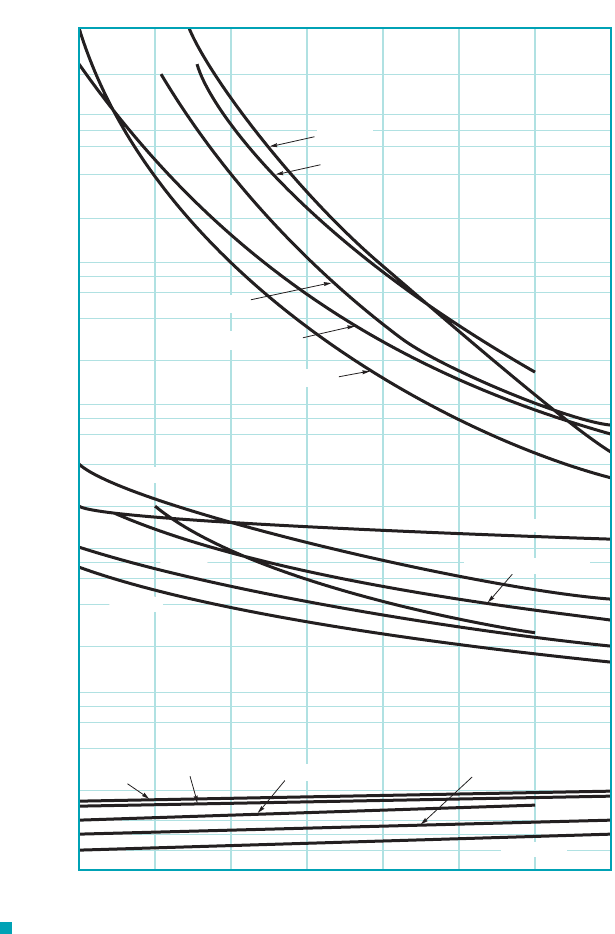
A
ppendix B
Physical Properties of Fluids
Methane
Carbon dioxide
Hydrogen
Helium
Heptane
Octane
Water
Carbon tetrachloride
Mercury
Kerosene
SAE 10W oil
SAE 10W-30 oil
SAE 30W oil
Castor oil
Glycerin
–20 0 20 40 60 80 100 120
Temperature, °C
4.0
2.0
1.0
8
6
4
2
1 × 10
–1
8
6
4
2
1 × 10
–2
8
6
4
2
1 × 10
–3
8
6
4
2
1 × 10
–4
8
6
4
2
1 × 10
–5
8
6
, Dynamic viscosity, N
•
s/m
2
µ
Air
F I G U R E B.1 Dynamic (absolute) viscosity of common fluids as a function
of temperature. To convert to BG units of multiply by
(Curves from R. W. Fox and A. T. McDonald, Introduction to Fluid Mechanics, 3rd Ed.,
Wiley, New York, 1985. Used by permission.)
2.089 ⴛ 10
ⴚ2
.N
ⴢ
s
Ⲑ
m
2
lb
ⴢ
s
Ⲑ
ft
2
714
JWCL068_AppB_714-718.qxd 9/23/08 12:07 PM Page 714
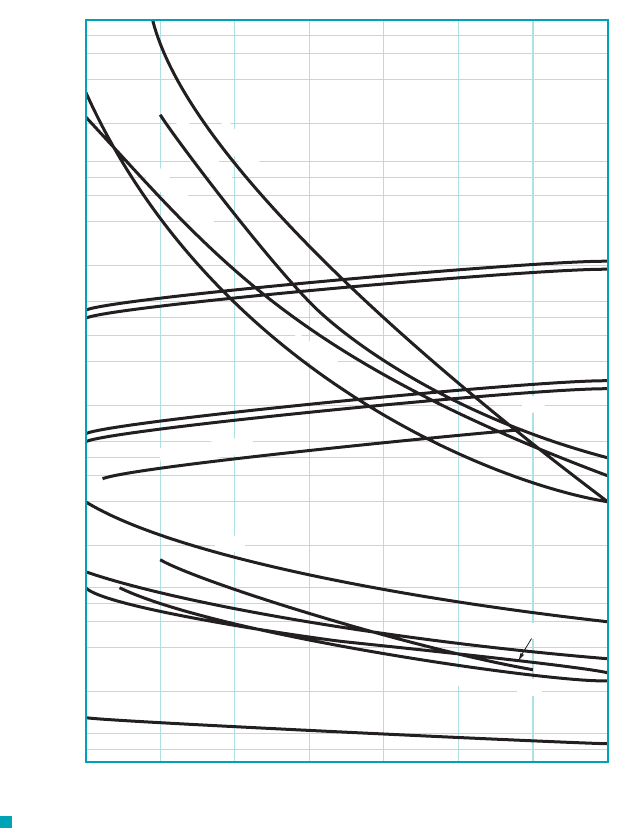
Appendix B ■ Physical Properties of Fluids 715
Carbon tetrachloride
Mercury
Octane
Water
Kerosene
Air
Carbon dioxide
Methane
Hydrogen
Helium
SAE 10W oil
SAE 10W–30 oil
SAE 30W oil
Glycerin
1 × 10
–2
8
6
4
2
1 × 10
–3
8
6
4
2
1 × 10
–4
8
6
4
2
1 × 10
–5
8
6
4
2
1 × 10
–6
8
6
4
2
1 × 10
–7
8
, Kinematic viscosity, m
2
/s
–20 0 20 40 60 80 100 120
Temperature, °C
Heptane
ν
F I G U R E B.2 Kinematic viscosity of common fluids (at atmospheric pres-
sure) as a function of temperature. To convert to BG units of multiply by 10.76.
(Curves from R. W. Fox and A. T. McDonald, Introduction to Fluid Mechanics, 3rd Ed.,
Wiley, New York, 1985. Used by permission.)
m
2
Ⲑ
sft
2
Ⲑ
s
JWCL068_AppB_714-718.qxd 9/23/08 12:07 PM Page 715

716 Appendix B ■ Physical Properties of Fluids
TABLE B.1
Physical Properties of Water ( )
a
Specific Dynamic Kinematic Surface Vapor Speed of
Density, Viscosity, Viscosity, Pressure,
Temperature c
( ) ( ) ( ) ( ) ( ) (lb兾ft) [ (abs)] (ft兾s)
32 1.940 62.42 4603
40 1.940 62.43 4672
50 1.940 62.41 4748
60 1.938 62.37 4814
70 1.936 62.30 4871
80 1.934 62.22 4819
90 1.931 62.11 4960
100 1.927 62.00 4995
120 1.918 61.71 5049
140 1.908 61.38 5091
160 1.896 61.00 5101
180 1.883 60.58 5195
200 1.869 60.12 5089
212 1.860 59.83 50621.469 E ⫹ 14.04 E ⫺ 33.165 E ⫺ 65.886 E ⫺ 6
1.152 E ⫹ 14.12 E ⫺ 33.393 E ⫺ 66.342 E ⫺ 6
7.507 E ⫹ 04.26 E ⫺ 33.827 E ⫺ 67.207 E ⫺ 6
4.736 E ⫹ 04.40 E ⫺ 34.385 E ⫺ 68.315 E ⫺ 6
2.888 E ⫹ 04.53 E ⫺ 35.106 E ⫺ 69.743 E ⫺ 6
1.692 E ⫹ 04.67 E ⫺ 36.067 E ⫺ 61.164 E ⫺ 5
9.493 E ⫺ 14.79 E ⫺ 37.383 E ⫺ 61.423 E ⫺ 5
6.979 E ⫺ 14.86 E ⫺ 38.233 E ⫺ 61.500 E ⫺ 5
5.069 E ⫺ 14.91 E ⫺ 39.262 E ⫺ 61.791 E ⫺ 5
3.631 E ⫺ 14.97 E ⫺ 31.052 E ⫺ 52.037 E ⫺ 5
2.563 E ⫺ 15.03 E ⫺ 31.210 E ⫺ 52.344 E ⫺ 5
1.781 E ⫺ 15.09 E ⫺ 31.407 E ⫺ 52.730 E ⫺ 5
1.217 E ⫺ 15.13 E ⫺ 31.664 E ⫺ 53.228 E ⫺ 5
8.854 E ⫺ 25.18 E ⫺ 31.924 E ⫺ 53.732 E ⫺ 5
lb
Ⲑ
in
2
.ft
2
Ⲑ
slbⴢs
Ⲑ
ft
2
lb
Ⲑ
ft
3
slugs
Ⲑ
ft
3
ⴗF
p
v
SNMGR
Sound
d
,Tension
c
,Weight
b
,
BG Units
a
Based on data from Handbook of Chemistry and Physics, 69th Ed., CRC Press, 1988. Where necessary, values obtained by interpolation.
b
Density and specific weight are related through the equation For this table,
c
In contact with air.
d
From R. D. Blevins, Applied Fluid Dynamics Handbook, Van Nostrand Reinhold Co., Inc., New York, 1984.
g ⫽ 32.174 ft
Ⲑ
s
2
.g ⫽ rg.
TABLE B.2
Physical Properties of Water ( )
a
Specific Dynamic Kinematic Surface Vapor Speed of
Density, Viscosity, Viscosity, Pressure,
Temperature c
() (
)
(
)
(
)
(
)
(N兾m) [
(abs)]
(m兾s)
0 999.9 9.806 1403
5 1000.0 9.807 1427
10 999.7 9.804 1447
20 998.2 9.789 1481
30 995.7 9.765 1507
40 992.2 9.731 1526
50 988.1 9.690 1541
60 983.2 9.642 1552
70 977.8 9.589 1555
80 971.8 9.530 1555
90 965.3 9.467 1550
100 958.4 9.399 15431.013 E ⫹ 55.89 E ⫺ 22.940 E ⫺ 72.818 E ⫺ 4
7.010 E ⫹ 46.08 E ⫺ 23.260 E ⫺ 73.147 E ⫺ 4
4.734 E ⫹ 46.26 E ⫺ 23.650 E ⫺ 73.547 E ⫺ 4
3.116 E ⫹ 46.44 E ⫺ 24.134 E ⫺ 74.042 E ⫺ 4
1.992 E ⫹ 46.62 E ⫺ 24.745 E ⫺ 74.665 E ⫺ 4
1.233 E ⫹ 46.79 E ⫺ 25.534 E ⫺ 75.468 E ⫺ 4
7.376 E ⫹ 36.96 E ⫺ 26.580 E ⫺ 76.529 E ⫺ 4
4.243 E ⫹ 37.12 E ⫺ 28.009 E ⫺ 77.975 E ⫺ 4
2.338 E ⫹ 37.28 E ⫺ 21.004 E ⫺ 61.002 E ⫺ 3
1.228 E ⫹ 37.42 E ⫺ 21.307 E ⫺ 61.307 E ⫺ 3
8.722 E ⫹ 27.49 E ⫺ 21.519 E ⫺ 61.519 E ⫺ 3
6.105 E ⫹ 27.56 E ⫺ 21.787 E ⫺ 61.787 E ⫺ 3
N
Ⲑ
m
2
m
2
Ⲑ
sNⴢs
Ⲑ
m
2
kN
Ⲑ
m
3
kg
Ⲑ
m
3
ⴗC
p
v
SNMGR
Sound
d
,Tension
c
,Weight
b
,
SI Units
a
Based on data from Handbook of Chemistry and Physics, 69th Ed., CRC Press, 1988.
b
Density and specific weight are related through the equation For this table,
c
In contact with air.
d
From R. D. Blevins, Applied Fluid Dynamics Handbook, Van Nostrand Reinhold Co., Inc., New York, 1984.
g ⫽ 9.807 m
Ⲑ
s
2
.g ⫽ rg.
JWCL068_AppB_714-718.qxd 9/23/08 12:08 PM Page 716
